Artificial intelligence has moved from a futuristic concept to a fundamental part of a modern marketing toolkit. Marketers are no longer asking if they should use AI, but which AI tools will deliver the most impact. The sheer volume of available platforms can be overwhelming, making it difficult to separate genuine productivity enhancers from overhyped software. This guide cuts through the noise.
We’ve compiled a definitive list of the best AI tools for marketers, designed to solve specific challenges you face daily. Whether you need to automate social media scheduling, generate high-converting ad copy, optimize your content for search engines, or create personalized email campaigns at scale, you'll find a solution here. This resource is built for action.
Each entry provides a concise overview, an honest look at key features and limitations, and practical use-case scenarios to see how it fits into your workflow. We also include current pricing information, screenshots for a real look at the interface, and direct links to get started. Our goal is to equip you with the detailed analysis needed to select the right platform, streamline your operations, and drive measurable results for your business. Let's explore the tools that will redefine your marketing strategy.
1. AIHuntList: Your Comprehensive AI Tool Discovery Hub
Finding the right tool in the rapidly expanding AI landscape can feel like searching for a needle in a haystack. For marketers aiming to build a truly effective tech stack, AIHuntList emerges as an indispensable starting point and our top recommendation. It's not a single-purpose tool but a powerful, comprehensive directory designed to streamline the discovery and comparison process, making it one of the best AI tools for marketers to have in their arsenal.
The platform’s core strength lies in its sheer scale and meticulous organization. With over 3,000 AI products meticulously sorted into more than 200 specialized categories, it eliminates the guesswork and endless searching. Marketers can dive into specific verticals like "AI SEO Tools," "AI Content Generators," or "AI Social Media Assistants" to find a curated list of relevant solutions. This saves invaluable time and ensures you are evaluating options specifically suited to your marketing objectives.
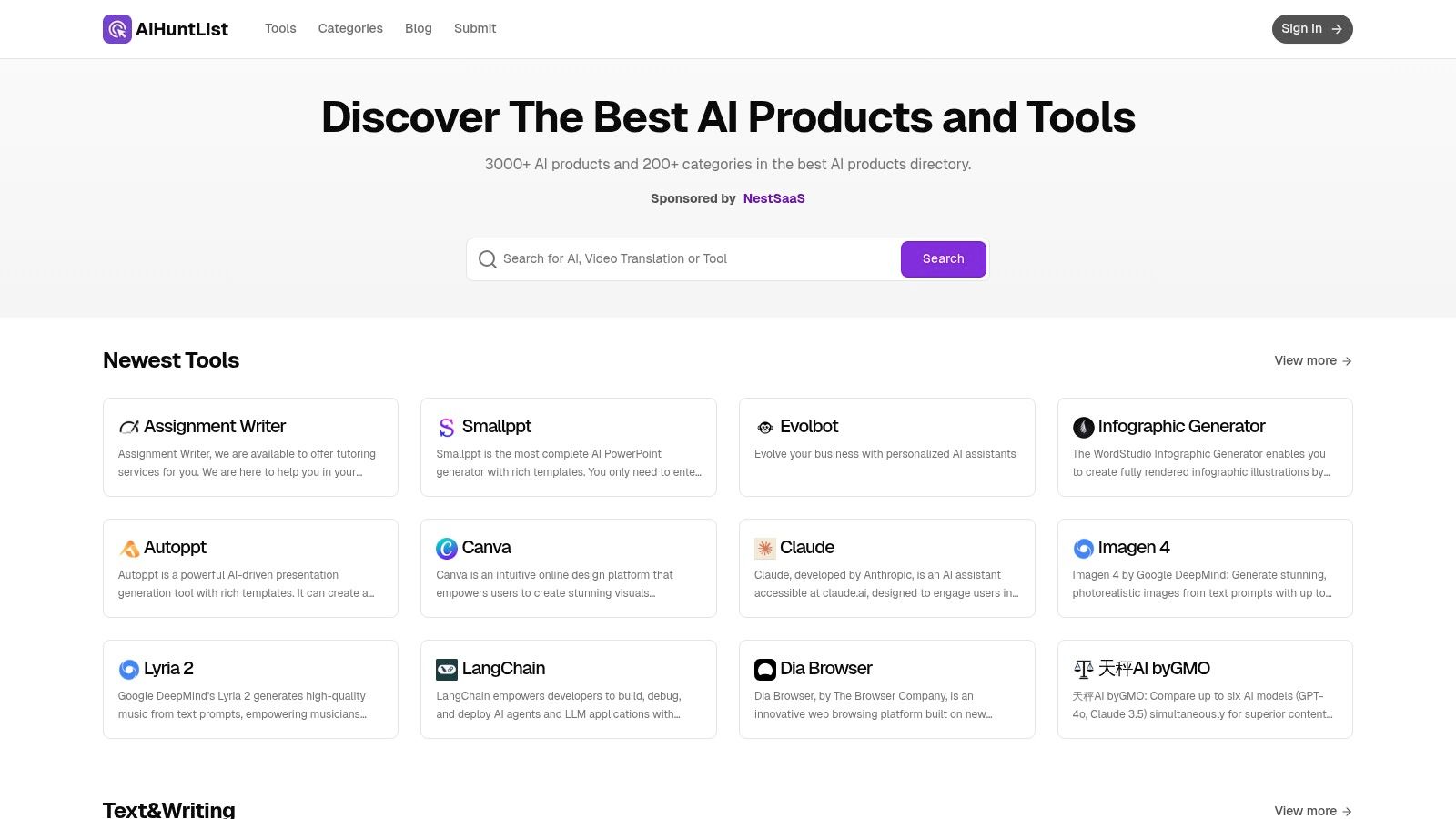
Why It Excels for Marketers
AIHuntList is more than a simple list; it's a strategic resource. Each listing includes a succinct overview and key feature highlights, allowing for rapid assessment. The user-friendly interface, complete with a seamless theme toggle for personalized viewing, enhances the browsing experience. The platform also fosters a vibrant community through user-submitted prompts and a rich blog, offering practical insights and real-world applications.
Key Features:
Expansive Directory: Access to over 3,000 AI tools across 200+ marketing-relevant categories.
Curated Listings: Each tool is presented with detailed overviews and specific use cases, helping you make informed decisions quickly.
Community Engagement: A user-driven prompt library and active blog provide practical strategies and inspiration.
Intuitive Interface: Clean, easy-to-navigate design that simplifies the search for the perfect tool.
Practical Use Case:
A content marketing manager can use AIHuntList to build a complete AI-powered workflow. They could start by exploring the "AI Writing Assistants" category to find a tool for generating blog post drafts, then move to "AI SEO Tools" to find a solution for keyword optimization, and finally, browse "AI Image Generators" to create custom visuals for their articles, all within a single platform.
Access: AIHuntList is completely free to use.
Website: https://aihuntlist.com
2. HubSpot Marketing Hub
HubSpot's Marketing Hub stands out not just as a single-purpose tool, but as a comprehensive, AI-integrated marketing ecosystem. While many platforms offer isolated AI features, HubSpot embeds artificial intelligence across its entire suite, making it one of the best AI tools for marketers who need an all-in-one solution. The platform excels at using AI to automate and personalize campaigns at scale, from generating blog post ideas to optimizing email send times for maximum engagement.
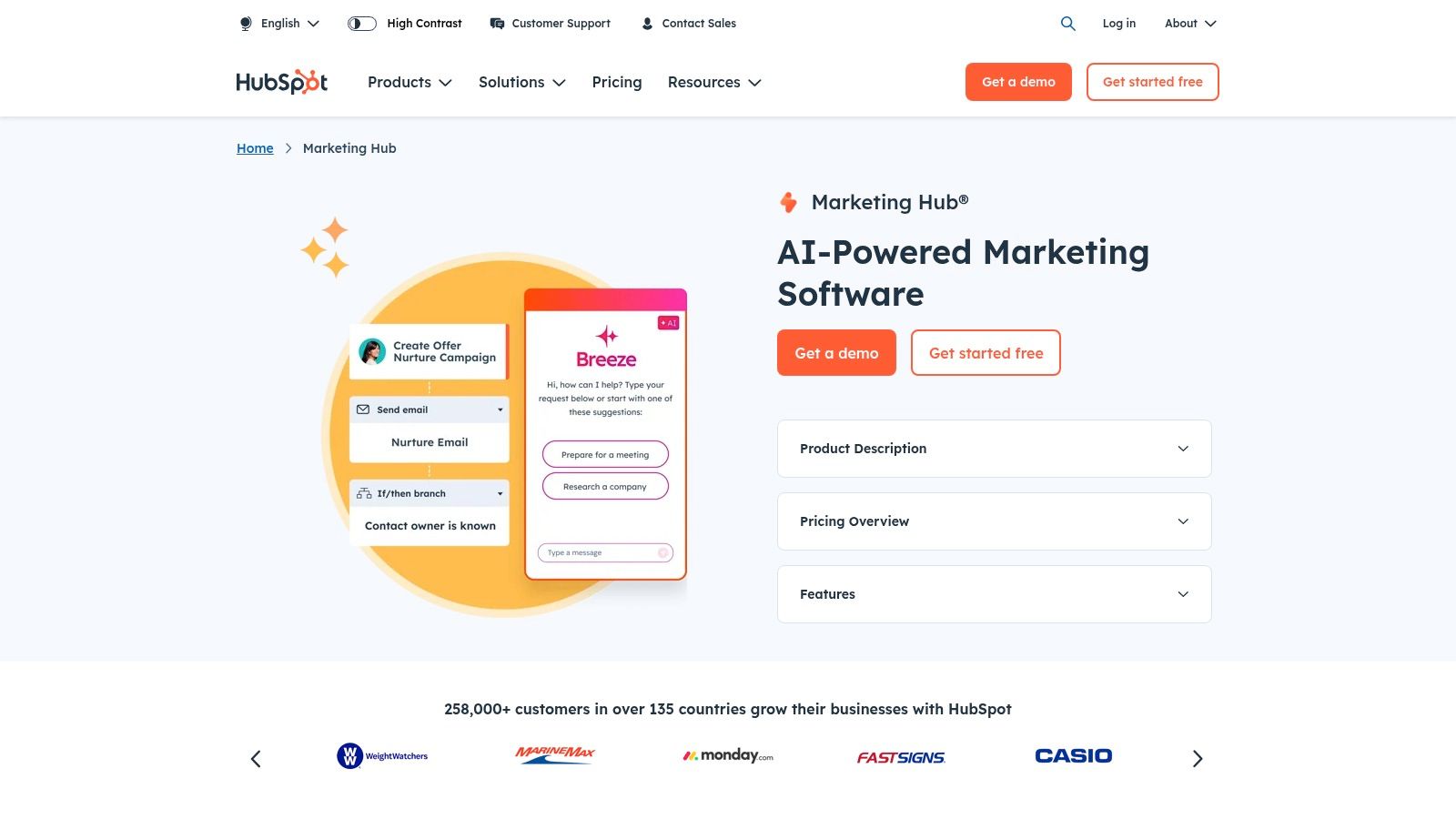
Its real power lies in unifying data. The AI-powered features like predictive lead scoring and content strategy tools draw from a central CRM, ensuring every action is informed by a complete customer view. This integration allows for a seamless transition from attracting leads to nurturing them, a process that is often disjointed with separate tools.
Key Features & Use Cases
AI Content Assistant: Instantly generate outlines, drafts, and even entire paragraphs for blog posts, social media updates, and marketing emails directly within the editor.
Predictive Lead Scoring: Automatically identify your most qualified leads based on their behavior and demographic data, allowing sales teams to prioritize outreach effectively.
SEO Recommendations: Get AI-driven suggestions on topics and keywords to build your content pillars, improving your site's authority and search rankings.
Pricing and Access
HubSpot's pricing structure is tiered, starting with a free plan that includes basic tools. The Starter plan begins at $18/month (billed annually) for individuals and small teams. Larger businesses will need the Professional or Enterprise plans, which can range from $800 to $3,600+ per month, unlocking advanced AI automation and analytics.
Pros & Cons
Pros: Its user-friendly interface is a major plus, and the comprehensive suite eliminates the need for multiple subscriptions. The platform's strong customer support is also a significant benefit for troubleshooting.
Cons: The main drawback is the cost, which can be prohibitive for small businesses or startups. Some of the advanced features also come with a notable learning curve.
Learn more about HubSpot's capabilities on Aihuntlist to see how it compares with other sales-focused platforms.
Website: HubSpot Marketing Hub
3. Jasper.ai
Jasper.ai has cemented its place as a go-to AI content generator, specifically engineered to help marketing teams produce high-quality, on-brand copy at an accelerated pace. It excels at transforming simple prompts into a wide variety of content formats, from compelling ad copy and social media captions to detailed blog posts. This makes it one of the best AI tools for marketers focused on overcoming writer's block and scaling content production without sacrificing quality.
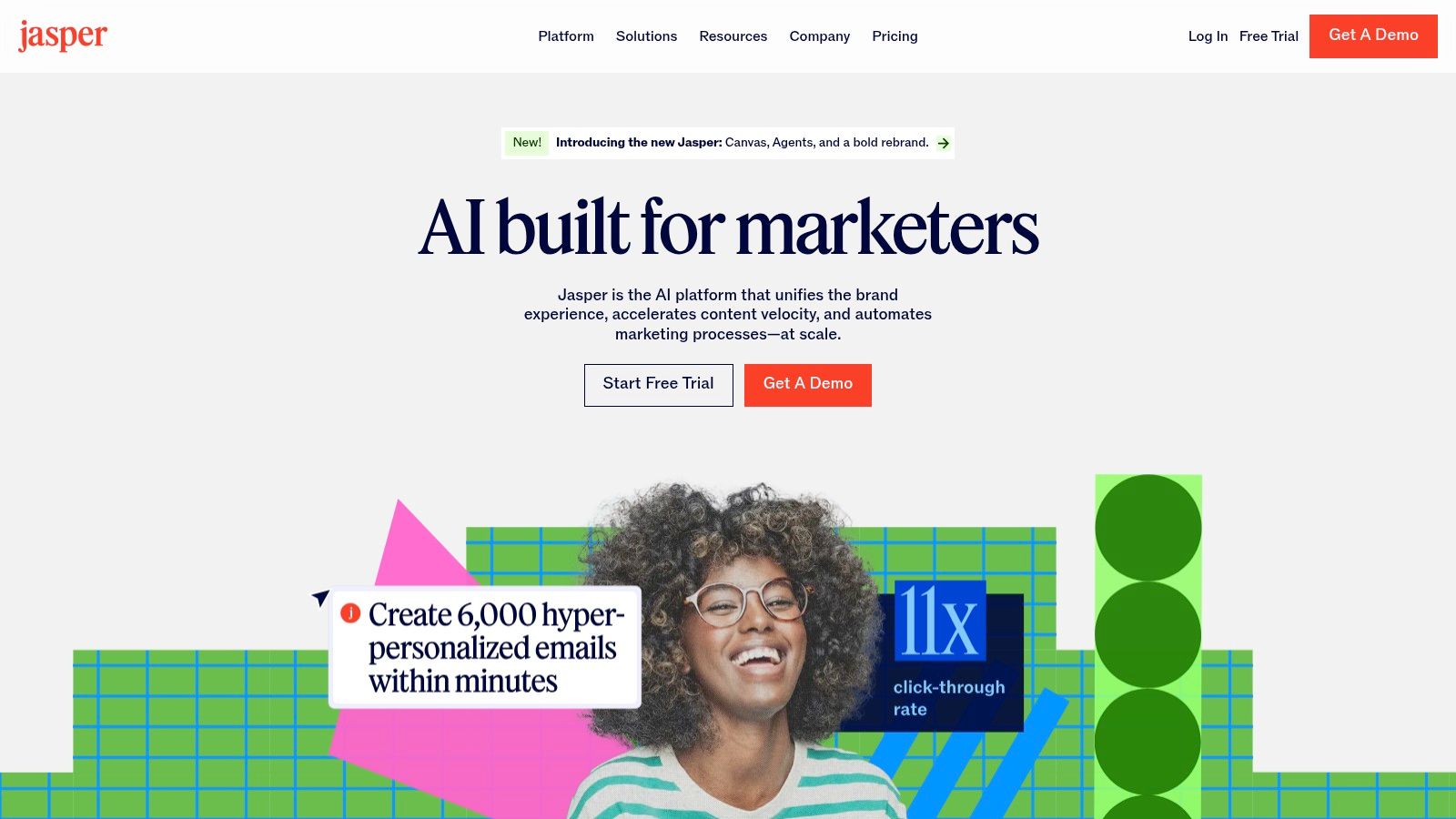
The platform’s key strength is its Brand Voice feature, which analyzes your existing content to learn your specific style, tone, and terminology. This ensures that every piece of generated text aligns with your established brand identity, a crucial element for maintaining consistency across all marketing channels. Its extensive library of templates provides a structured starting point for virtually any marketing task.
Key Features & Use Cases
Brand Voice & Knowledge Base: Train Jasper on your company's style guides, product catalogs, and website content to generate copy that is consistently on-brand.
Extensive Template Library: Access over 50 pre-built templates for specific marketing needs, including AIDA frameworks, blog post intros, and YouTube video descriptions.
Multi-Language Support: Create and translate marketing content into over 30 languages, allowing teams to scale their campaigns globally with ease.
Pricing and Access
Jasper offers several plans tailored to different needs. The Creator plan is designed for individuals and starts at $39/month (billed annually). The Pro and Business plans offer more advanced features like team collaboration and custom brand voices, with pricing available upon request for custom enterprise solutions. A free trial is typically available to test its capabilities.
Pros & Cons
Pros: The highly intuitive interface makes it easy for anyone to start generating content quickly. It is a massive time-saver for repetitive content creation tasks.
Cons: The generated content almost always requires a final layer of manual editing for accuracy and nuance. The pricing can be a significant investment for freelancers or small businesses.
Learn more about Jasper's content capabilities on Aihuntlist and see how it stacks up against other AI story-generation tools.
Website: Jasper.ai
4. Zapier
Zapier acts as the central nervous system for a modern marketing stack, connecting disparate tools to create seamless automated workflows. While not a content generator itself, it’s one of the best AI tools for marketers because it automates the manual processes that surround AI-driven tasks. For instance, you can automatically send a lead generated by an AI chatbot directly into your CRM, or trigger a social media post whenever a new AI-generated blog article is published.
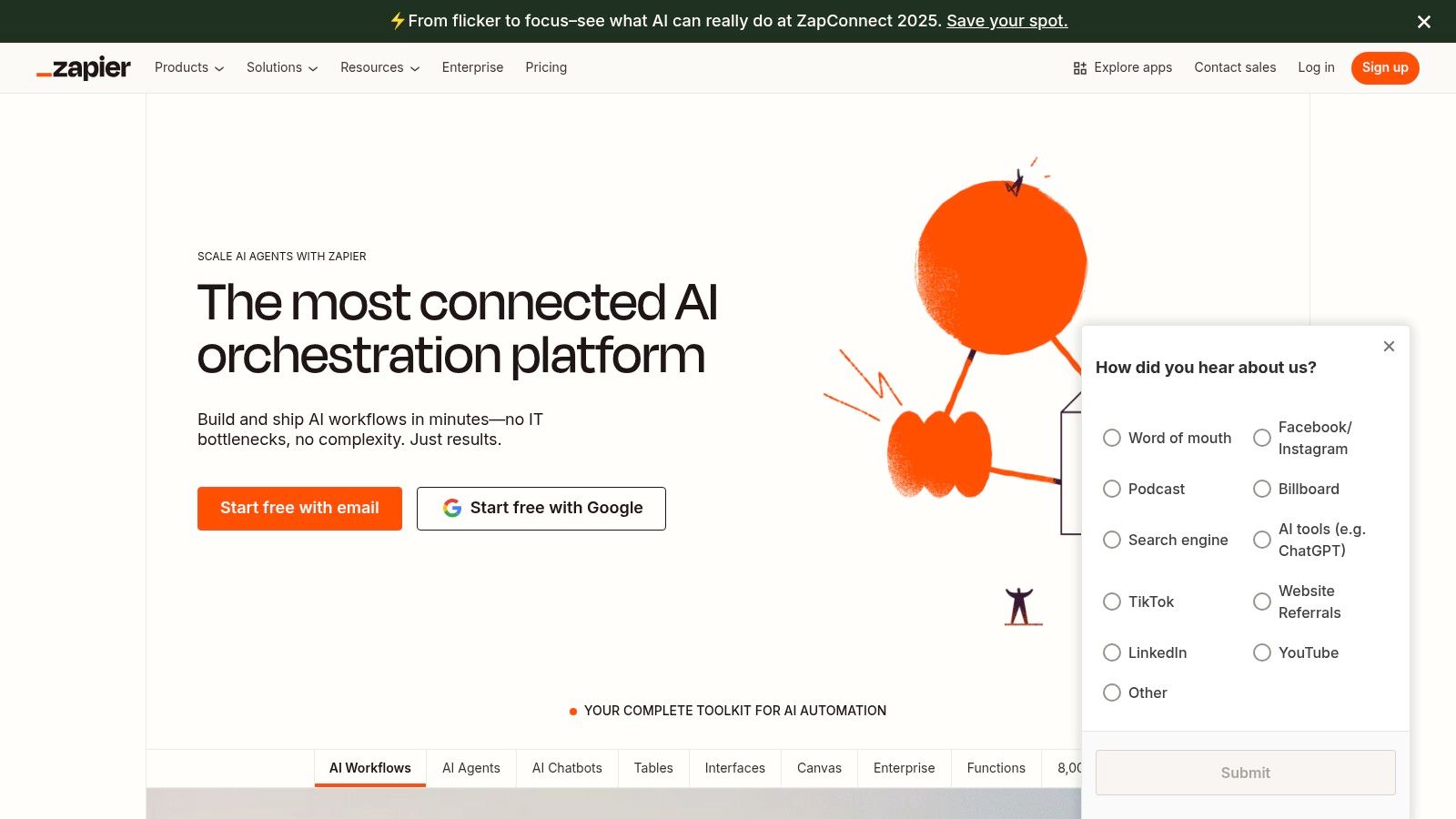
Its no-code interface allows marketers without technical expertise to build powerful "Zaps" that connect over 7,000 different applications. This capability is crucial for maximizing ROI on other AI tools, ensuring that the insights and content they produce are immediately put to work across your entire marketing ecosystem. Recently, Zapier has also integrated AI into its builder, allowing you to describe a workflow in plain English and have the platform suggest the necessary steps.
Key Features & Use Cases
AI-Powered Workflow Builder: Describe the automation you want in simple terms, and Zapier's AI will help you construct the multi-step Zap.
Extensive App Integrations: Connect virtually any tool in your marketing arsenal, from social media schedulers and email platforms to AI content writers and analytics dashboards.
Pre-built Templates: Get started quickly with thousands of ready-made workflow templates designed for common marketing tasks like lead management and content distribution.
Pricing and Access
Zapier offers a free plan with limited, single-step Zaps. Paid plans unlock multi-step Zaps and premium app integrations, starting with the Starter plan at $19.99/month (billed annually). The Professional and Team plans offer more tasks and advanced features, with pricing increasing accordingly to accommodate higher usage and more complex needs.
Pros & Cons
Pros: The sheer number of app integrations is unmatched, and its user-friendly, no-code setup saves countless hours on repetitive tasks. It's incredibly easy to get started.
Cons: The cost can escalate quickly as your task volume increases. Some complex, multi-step workflows may have limitations or require a higher-tier plan to execute properly.
Website: Zapier
5. Surfer SEO
Surfer SEO distinguishes itself by focusing squarely on data-driven on-page optimization, making it one of the best AI tools for marketers dedicated to dominating search engine results. It moves beyond simple keyword suggestions by analyzing the top-ranking pages for a target query and providing a detailed, actionable blueprint for your content. The platform's AI generates a real-time optimization score based on factors like keyword density, structure, and readability.
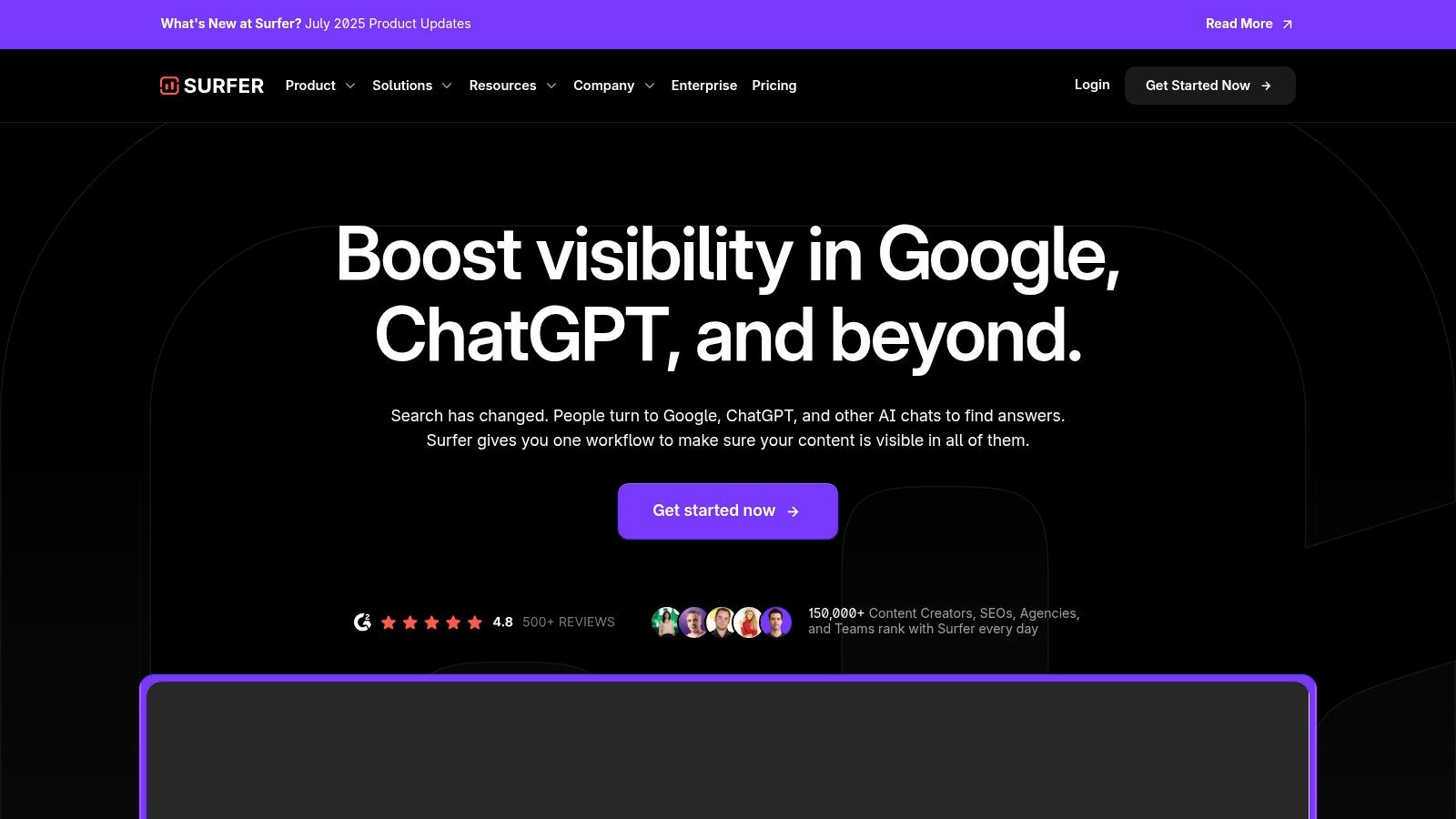
This granular, SERP-based analysis is what sets Surfer SEO apart. Instead of offering generic advice, it gives you a competitive roadmap to follow. The integration with popular writing tools like Google Docs and WordPress allows writers to optimize content directly within their existing workflows, streamlining the entire SEO content creation process from research to publication.
Key Features & Use Cases
Content Editor: Get real-time feedback and suggestions on keyword usage, headings, and paragraph count as you write to meet optimal on-page SEO standards.
SERP Analyzer: Deconstruct the top-ranking pages for any keyword to understand common patterns in word count, backlinks, and content structure.
Keyword Research: Discover related keyword clusters and questions people are asking to build comprehensive articles that cover a topic in depth.
Pricing and Access
Surfer SEO operates on a subscription model. The Essential plan starts at $89/month for individuals and freelancers. The Advanced plan, aimed at in-house teams, is priced at $179/month, while the Max plan for agencies costs $299/month, offering more credits for its AI tools and features.
Pros & Cons
Pros: The platform provides highly actionable, data-backed SEO insights that are easy to follow. Its user-friendly interface and integrations make it simple to adopt.
Cons: The pricing can be a significant investment for small businesses or solo bloggers. There is also a learning curve for beginners to fully leverage all its analytical features.
Website: Surfer SEO
6. Synthesia
Synthesia is a powerful AI video generation platform that revolutionizes how marketers create visual content. It enables users to produce professional-grade videos featuring realistic AI avatars from simple text scripts, eliminating the need for cameras, microphones, or complex editing software. This makes it one of the best AI tools for marketers looking to scale video production for training materials, product demos, or internal communications quickly and affordably.
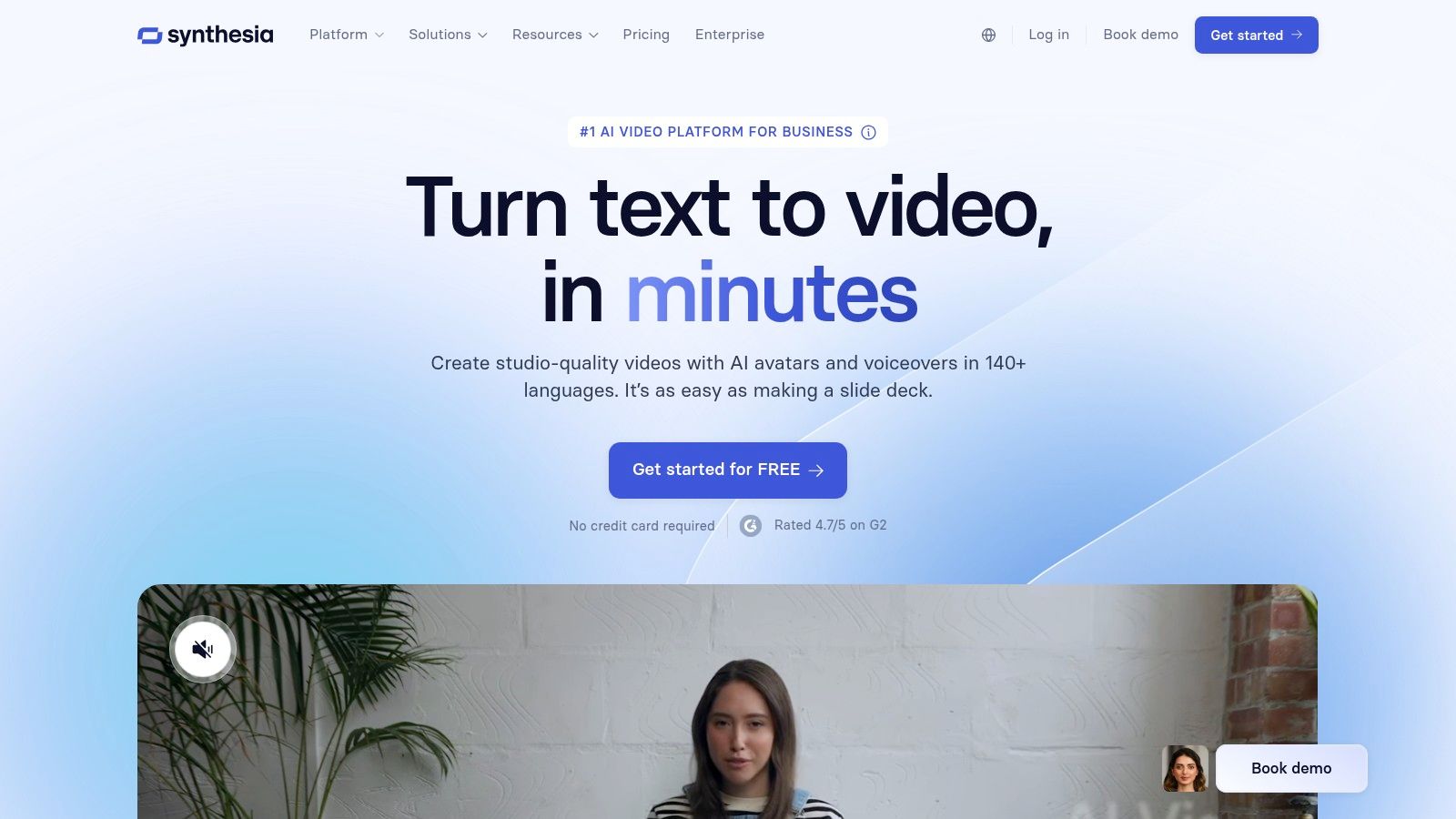
The platform's standout feature is its ability to localize content effortlessly. By supporting over 120 languages and accents, marketers can create tailored video campaigns for global audiences without the high costs of reshooting or hiring multilingual actors. This democratizes video creation, making it accessible even for teams without specialized video production skills.
Key Features & Use Cases
AI Avatars and Voices: Choose from a diverse library of stock avatars or create a custom digital twin of yourself to serve as the presenter.
Multi-language Support: Convert text to speech in over 120 languages, making it ideal for creating localized marketing and training videos.
Customizable Templates: Use pre-designed templates to speed up video creation for various use cases like sales pitches, how-to guides, and social media content.
Simple Media Uploads: Easily integrate your own brand assets, images, and background videos to maintain brand consistency.
Pricing and Access
Synthesia offers a tiered pricing model. The Personal plan is available for individuals starting at $22/month (billed annually), which includes 10 minutes of video per month. For businesses, the Creator and Enterprise plans offer more video minutes, custom avatars, and collaboration features, with pricing available upon request through a consultation with their sales team.
Pros & Cons
Pros: Significantly reduces video production time and costs. The intuitive interface requires no prior video editing experience. Its extensive language support is a major advantage for international campaigns.
Cons: The AI voices can sometimes lack natural emotional inflection. Customization options for avatar gestures and expressions are still somewhat limited, and costs can increase quickly with heavy usage.
Website: Synthesia
7. Semrush
Semrush has long been a heavyweight in the digital marketing world, but its integration of AI has solidified its place as one of the best AI tools for marketers focused on SEO and content strategy. The platform uses AI not just for data analysis but to provide actionable, forward-looking recommendations that help marketers outmaneuver competitors. It excels at transforming complex datasets from keyword research, backlink profiles, and technical site audits into clear, prioritized tasks.
What sets Semrush apart is the depth of its competitive analysis tools, powered by a massive database and AI algorithms. It doesn’t just show you what keywords you rank for; it reveals your competitors' entire strategy, from their top-performing content to their ad copy, allowing you to identify and exploit gaps in the market with data-driven confidence.
Key Features & Use Cases
Keyword Magic Tool: Utilizes AI to generate vast lists of related keywords, questions, and long-tail variations, helping you build comprehensive topic clusters.
Content Optimization: The SEO Writing Assistant provides real-time, AI-driven feedback on your content's readability, SEO, tone of voice, and originality as you write.
Competitor & Backlink Analysis: AI algorithms analyze competitor backlink profiles and content strategies to uncover high-impact link-building and content opportunities.
Pricing and Access
Semrush offers several plans. The Pro plan starts at around $129.95/month, designed for freelancers and small teams. The Guru plan, at $249.95/month, is better for SMEs and growing agencies, while the Business plan at $499.95/month is suited for large enterprises with extensive needs. A limited free account is also available.
Pros & Cons
Pros: It’s a true all-in-one marketing toolkit, providing comprehensive and actionable insights. The platform is constantly updated with new features and improvements.
Cons: The pricing can be a significant investment for small businesses or solo marketers. The sheer number of features and data can feel overwhelming for beginners.
Website: https://www.semrush.com/
8. Sprout Social
Sprout Social distinguishes itself by integrating powerful AI into a comprehensive social media management platform. It goes beyond simple scheduling, offering sophisticated AI-driven tools for social listening and sentiment analysis. This makes it one of the best AI tools for marketers who need to understand not just what is being said about their brand, but the underlying emotion and context behind the conversations.
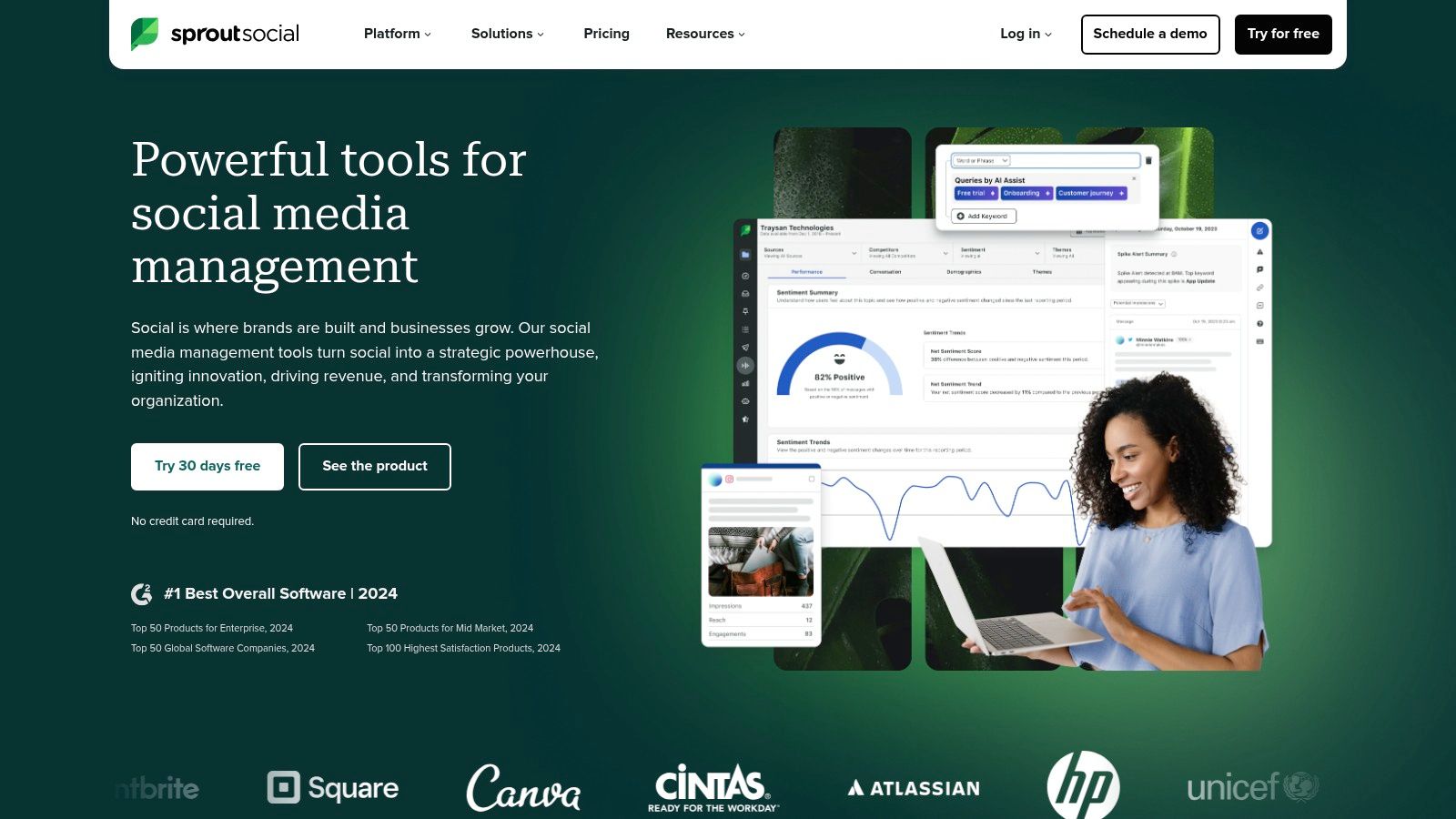
The platform's strength lies in transforming raw social data into actionable insights. Its AI features help identify trends, measure campaign performance, and optimize content delivery across multiple channels. This allows marketing teams to make data-backed decisions, from crafting more resonant messages to scheduling posts at the exact moment their audience is most active.
Key Features & Use Cases
Social Listening & Sentiment Analysis: Use AI to monitor brand mentions and keywords, automatically classifying posts as positive, negative, or neutral to gauge public perception.
Smart Scheduling: Let the AI-powered ViralPost® feature determine the optimal times to publish content for maximum reach and engagement based on audience behavior.
Comprehensive Analytics: Generate detailed reports that track performance metrics across platforms, providing insights into audience demographics and content effectiveness.
Pricing and Access
Sprout Social offers several subscription tiers. The Standard plan starts at $249 per month (billed annually) for a single user. The Professional plan is $399 per month, adding more advanced features. Larger teams and agencies will likely need the Advanced plan at $499 per month for full access to its suite of tools.
Pros & Cons
Pros: The platform is known for its user-friendly interface and exceptionally robust analytics. Its customer support is frequently praised for being responsive and helpful.
Cons: The main drawback is the price point, which can be steep for small businesses or solo entrepreneurs. Some of the most valuable features are restricted to higher-tier plans.
Website: Sprout Social
9. Hootsuite
Hootsuite has long been a staple in social media management, and its integration of AI cements its position as one of the best AI tools for marketers focused on social channels. The platform excels at centralizing social media workflows, using AI not just for creation but for strategic scheduling and performance analysis. This makes it ideal for teams needing to manage multiple accounts efficiently while maintaining a consistent brand voice.
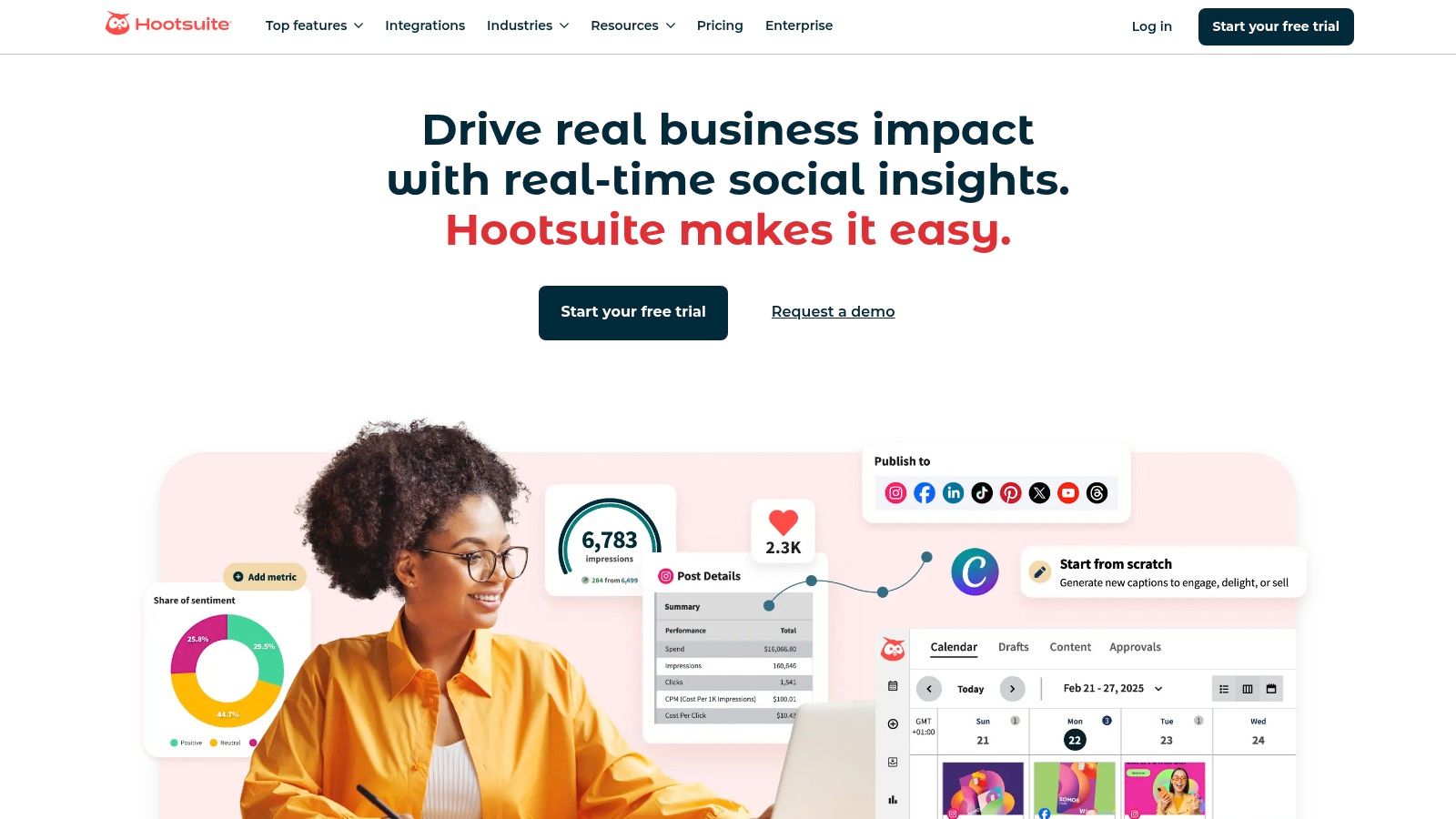
Its core AI strength lies in OwlyWriter AI, which helps overcome creative blocks by generating captions, post ideas, and hashtag suggestions tailored to specific platforms. Hootsuite’s analytics also leverage AI to recommend the best times to post for maximum reach and engagement, taking the guesswork out of social media timing and helping marketers optimize their content delivery strategy based on audience behavior.
Key Features & Use Cases
OwlyWriter AI: Instantly generate social media copy, repurpose high-performing content, and create relevant captions for any social network.
Best Time to Publish: Get AI-powered recommendations on when to schedule posts to reach your audience when they are most active and engaged.
Social Listening & Analytics: Monitor brand mentions, track sentiment, and analyze campaign performance with comprehensive, AI-enhanced reporting tools.
Pricing and Access
Hootsuite offers several plans. The Professional plan starts at $99 per month for one user and 10 social accounts. The Team plan is $249 per month for 3 users and 20 accounts. Larger organizations can opt for custom Business or Enterprise solutions with more advanced features and support. A 30-day free trial is available for the Professional and Team plans.
Pros & Cons
Pros: Its all-in-one dashboard simplifies managing numerous social profiles. The AI-powered content and scheduling tools save significant time and improve post performance.
Cons: The pricing can be a hurdle for freelancers or very small businesses. Some of the more advanced analytics features may have a learning curve for new users.
Website: Hootsuite
10. Mailchimp
Mailchimp has evolved from a simple email newsletter service into a sophisticated marketing platform, making it one of the best AI tools for marketers focused on audience engagement. The platform leverages AI to demystify complex data, offering predictive insights and smart recommendations that empower users to send more effective campaigns. Its strength lies in making advanced automation and personalization accessible to businesses of all sizes, from solopreneurs to established enterprises.
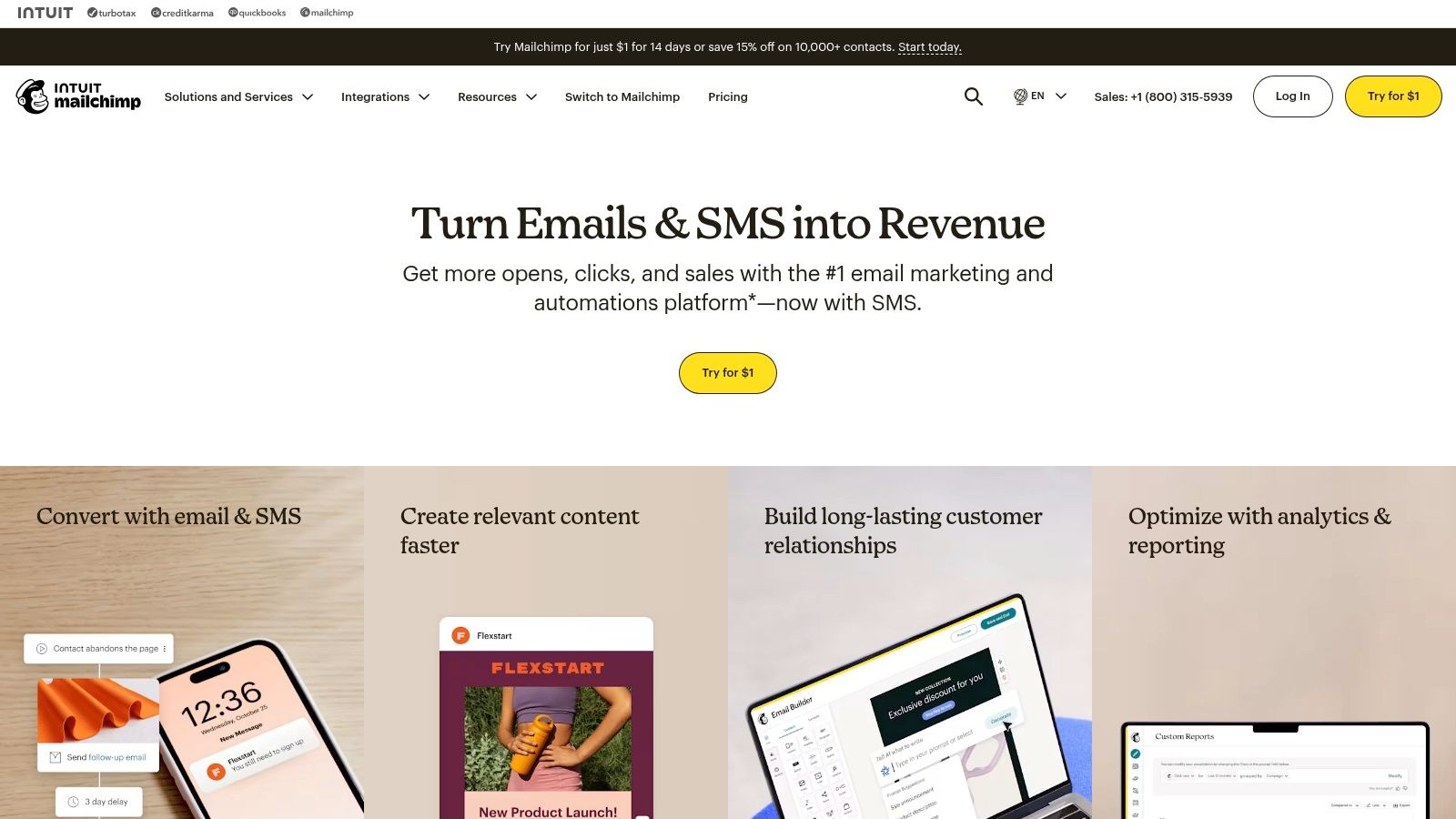
The AI-driven features are seamlessly integrated into the user workflow. For example, the Content Optimizer analyzes email copy against millions of industry data points to provide actionable improvement suggestions. This practical application of AI helps marketers refine their messaging to boost open rates and conversions without needing a data science background.
Key Features & Use Cases
Predictive Analytics: Forecast customer lifetime value and purchase likelihood to create high-value audience segments for targeted campaigns.
Content Optimizer: Get real-time, AI-powered suggestions on your email's readability, tone, and link structure to improve overall performance.
Send Time Optimization: Let Mailchimp's AI determine the ideal time to send your email to each individual subscriber, maximizing the chance it gets opened.
Creative Assistant: Automatically generate on-brand designs for your marketing assets by pulling colors, logos, and fonts directly from your website.
Pricing and Access
Mailchimp offers a tiered pricing model, including a free plan for up to 500 contacts with basic features. Paid plans start with Essentials at $13/month and scale up to the Standard ($20/month) and Premium ($350/month) tiers, which unlock more advanced AI features, larger contact lists, and more monthly sends.
Pros & Cons
Pros: The platform is renowned for its user-friendly interface and robust analytics. Its extensive integration library allows it to connect with hundreds of other business apps.
Cons: Costs can escalate quickly as your subscriber list grows. Access to the most powerful AI and predictive features is restricted to higher-tier, more expensive plans.
Discover how Mailchimp’s email focus compares to other builders on Aihuntlist to find the right fit for your campaign needs.
Website: Mailchimp
11. Drift
Drift pioneered the conversational marketing category, and its AI-powered platform remains a top choice for engaging website visitors in real-time. Instead of making potential customers fill out static forms, Drift uses intelligent chatbots to initiate conversations, qualify leads, and book meetings 24/7. This approach transforms a passive website into an active sales and marketing channel, making it one of the best AI tools for marketers focused on immediate lead engagement and conversion.
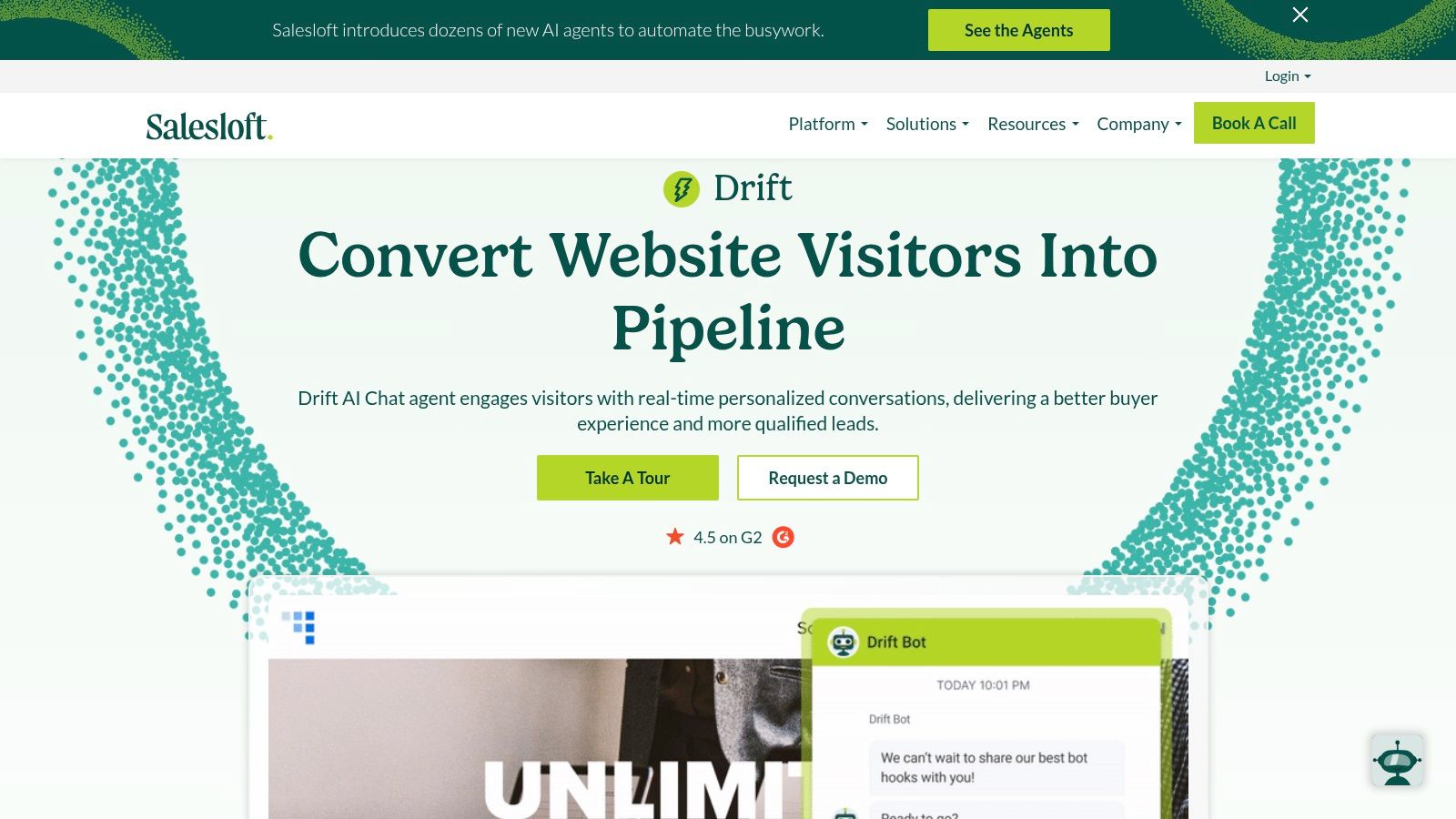
The platform's strength is its ability to deliver personalized experiences at scale. The AI analyzes visitor behavior and firmographic data to tailor conversations, ensuring the right message is delivered to the right person at the right time. This automated, yet personal, interaction helps streamline the sales funnel by connecting high-intent buyers directly with sales reps, shortening the sales cycle significantly.
Key Features & Use Cases
AI-Powered Chatbots: Engage visitors with automated, human-like conversations to answer questions, provide resources, and qualify interest without human intervention.
Lead Qualification and Routing: Automatically identify high-value leads based on conversation data and website activity, then instantly route them to the correct sales team member.
Predictive Analytics: Use AI to identify target accounts that are most likely to buy, allowing marketing teams to focus their efforts on high-potential prospects.
Pricing and Access
Drift’s pricing is customized based on business needs and is not publicly listed, typically requiring a conversation with their sales team. It’s generally geared towards mid-market and enterprise companies. The plans are tiered, starting with a Premium plan for smaller businesses and scaling up to Advanced and Enterprise plans that include more sophisticated AI features and integrations.
Pros & Cons
Pros: Significantly improves on-site customer engagement and accelerates the lead qualification process. Its deep integration capabilities with major CRMs and marketing automation platforms are a huge asset.
Cons: The custom pricing can be a major investment, making it less accessible for small businesses or startups. Some of the more advanced features can also require a technical setup process.
Website: Drift
12. Omneky
Omneky is a specialized AI platform focused on generating and optimizing advertising creatives, making it one of the best AI tools for marketers who need to scale their ad campaigns. It distinguishes itself by using AI not just to create visuals, but to analyze performance data and iterate on creative concepts across multiple channels like Meta, Google, and TikTok. This data-driven approach ensures that ad spend is directed toward the most effective visuals and messaging.
The platform streamlines the entire creative workflow, from generating initial briefs based on performance goals to producing hundreds of ad variations tailored to specific audiences. Omneky's strength is its ability to connect creative output directly with campaign results, closing a loop that is often managed manually by marketing teams. This makes it ideal for performance-focused marketers who need to continuously test and refine their ads.
Key Features & Use Cases
AI-Generated Ad Creatives: Automatically produce a wide range of images, videos, and ad copy based on your brand guidelines and campaign objectives.
Omnichannel Campaign Management: Deploy and manage AI-generated creatives across various advertising platforms from a single, unified dashboard.
Performance Analytics: Gain detailed insights into which creative elements are driving conversions, allowing for data-backed optimization.
Pricing and Access
Omneky's pricing is not publicly listed on their website. Prospective users need to book a demo to receive a custom quote tailored to their specific needs, such as the number of platforms and the scale of ad creation required. This bespoke model suggests it is geared toward businesses with significant advertising budgets.
Pros & Cons
Pros: Directly enhances ad performance by linking creative production to analytics. It effectively streamlines the often time-consuming creative process and supports major advertising platforms.
Cons: The lack of transparent pricing can be a barrier for initial evaluation. It may also require integration with your existing marketing stack to realize its full potential.
Website: Omneky
Integrating AI: Your Next Steps to a Smarter Marketing Strategy
Navigating the expansive landscape of artificial intelligence can feel overwhelming, but as we've explored, the right tools can transform your marketing efforts from reactive to revolutionary. This guide has detailed some of the best AI tools for marketers, from comprehensive platforms like HubSpot and Semrush that streamline entire workflows, to specialized solutions like Jasper for content creation and Synthesia for video production. The key takeaway is clear: AI is no longer a futuristic concept but a practical, accessible asset for modern marketing teams.
The power of these tools lies in their ability to automate repetitive tasks, uncover deep audience insights, and personalize customer experiences at a scale previously unimaginable. Whether you're optimizing SEO with Surfer SEO, managing complex social media strategies with Sprout Social, or automating lead generation with Drift, AI acts as a force multiplier, freeing up your team to focus on high-level strategy and creativity.
How to Choose the Right AI Marketing Tool
Selecting the perfect tool from this extensive list requires a strategic approach. Avoid the temptation to adopt a tool simply because it's popular. Instead, begin with a clear audit of your current marketing challenges and goals.
Identify Your Biggest Bottleneck: Where are you losing the most time? Is it content creation, lead qualification, data analysis, or social media scheduling? Your biggest pain point is the best place to start. If content is your hurdle, Jasper or Surfer SEO are excellent starting points. If workflow automation is the goal, Zapier is a must-have.
Consider Your Existing Tech Stack: The best AI tools for marketers are those that integrate seamlessly with your current software. Check for native integrations with your CRM, email marketing platform, and analytics dashboards. A tool that works in harmony with your existing systems, like HubSpot's integrated suite, will prevent data silos and ensure a smooth implementation.
Start Small and Scale: You don't need to overhaul your entire strategy overnight. Begin with a single, high-impact use case. Implement a tool to solve one specific problem, measure its ROI, and then expand its application or introduce new tools as you gain confidence and see results. Many tools like Mailchimp offer AI features within familiar platforms, making the initial step less daunting.
Implementing for Success
Once you've selected a tool, successful implementation is crucial. Ensure your team receives proper training and understands not just how to use the tool, but why it's being used. Set clear key performance indicators (KPIs) to track its impact on efficiency, lead quality, conversion rates, and overall campaign performance. Remember that AI is a partner, not a replacement for human ingenuity. The most successful strategies will combine the analytical power of AI with the creative, empathetic, and strategic oversight of skilled marketers.
The journey into AI-powered marketing is an ongoing process of learning, testing, and adapting. By taking these deliberate next steps, you can harness the power of artificial intelligence to not only meet your current objectives but to build a more agile, intelligent, and effective marketing strategy for the future.
Ready to discover the next game-changing AI tool for your marketing stack? The world of AI evolves daily, and staying ahead is crucial. Visit AIHuntList, your comprehensive and constantly updated directory for the latest and best AI tools for marketers and professionals in any field.
